Table of Contents
Fascinating Guitar Synths
Historic Overview
I have long been fascinated by concept of guitar synths. The idea of being able to play any instrument, via the guitar, seemed to be a dream come true. Unfortunately, the dream has never been fully realized, as the technology has failed in one way or another to deliver perfect tracking in an affordable package.
I’m happy to say that things have gotten a lot better over the years. I’ll share some of my experiences with guitar synths from the mid-1980’s to 2020. Although I have played several guitar synths over the years, I will focus on the three which were able to perform the best, in both a studio and live situation.
The Early Days
Guitar synths in their various forms have been around for decades. In the 1970’s a few models appeared, but these were not really worth pursuing for various reasons. However, in the late 1970’s we caught our first glimpse of the potential of the technology, with the introduction of Pitch to Voltage translation.
Pitch to Voltage translation took the output pitch (note played) and translated it into a voltage that was analyzed and then used to trigger a synthesizer sound. The units from this era were expensive and weren’t able to deliver the type of performance that guitarists were looking for. However, they provided the foundation on which to build future models.
The important thing to remember about Pitch to Voltage is that the lower notes have a slower waveform to be read, while the higher notes vibrate at a more rapid rate. The rapid notes can be read quickly, as a complete cycle of the note is necessary for translation, while the lower notes take more time to complete a cycle. Example A=440 vibrates 4 x faster than A=110.
The 1980’s
Due in part to the explosion of MIDI (Musical Instrument Digital Interface) In the 1980’s there was a bit of a revival of interest, as several companies introduced models that were mainly based on Pitch to Voltage, while others experimented with other approaches. It was during this time that Roland introduced their G-707 guitar controller, as well as making their hexaphonic pickup available for other guitars. Ibanez released their IMC-1 controller, which for me was the first affordable and playable guitar synth system. (See below) And units such as the Photon system showed potential.
It was during this period that various manufacturers started to really push the notion of the guitar synth. High end companies such as Synclavier entered the market with a product that was well outside the price range of working musicians. Others such as SynthAxe were used by artists such as Allan Holdsworth, yet used a different triggering system, and required players to adapt their techniques to a new method of playing.
In the late ’80’s I had purchased a Yamaha G-10 guitar synth system that consisted of a controller and rack mount unit. This unit used sonar as a triggering mechanism, as it sent a sonar beam down the string and translated the distance from the emitter to the fretted note, into a pitch. (See below)
Present Day
Guitar synths in general did not really catch on with the masses, due in large part to the inaccuracies of the Pitch to Voltage method, it was years before companies would even show any further interest in the subject. However, with the explosion of computer speed and technology, the Pitch to Voltage systems made remarkable improvements, almost to the point of being “completely usable”. Currently I have been using the Fishman Triple Play unit which is wireless and attaches to your guitar and it has been working out surprisingly well. (See below)
Techniques
Bending
Although bending strings is possible on guitar controllers, I’ve never felt that it was as natural as regular guitar bends. A lot of it has to do with how you set up the guitar controller and the synthesizer that is receiving the information. Some sounds react better than others.
Tremelo Bar
Similar to bending, the use of a tremolo bar on a guitar controller lacks the same type of feel as a normal bar. The range of the bend can be adjusted via the controller unit and synthesizer. I never found it to be very usable, however, perhaps if I spent more time calibrating it, it might have been more useful.
Breath Controller
For me, this is the most interesting and expressive tool available for the serious guitar synth player. There is a certain satisfaction that is obtained by playing a horn synth patch or sample and being able to control the shape and dynamics of the note by breathing harder or softer into the unit. A breath controller input must be available on the controller in order to use it. I used to use a Yamaha BC-2 breath controller.
Guitar/Synth Mix
Perhaps one of the most popular techniques for guitar synths is the mixing of a regular guitar signal along with a synthesizer sound. This can often lead to spectacular results, especially when used with a pad as a chord foundation, or for doubling single note lines. There’s lots of great combinations available here.
Mono Mode
There are essentially two ways to use a synthesizer with a controller, Mono Mode or Poly Mode. Polymode is the standard mode where all the notes/strings that you play are broadcast over one MIDI channel and trigger the same sound. Mono Mode is where each string is sent over a separate Midi channel and each channel can have a separate sound, if desired. This also allows each each string to be bent without it affecting the other strings. Multitimbral synths can take advantage of Mono Mode.
Hybrid Guitar
When using Mono Mode or Split Mode, the strings of the guitar controller can be assigned different sounds. One of the more interesting aspects for Contrapuntal Improvisation is setting up the bottom 2 or 3 strings to a Standup Bass sound and the upper 3 or 4 strings to a Piano, Sax, Trumpet, etc. This will give you an experience similar to playing a Hybrid Guitar, yet with more possibilities.
My Controllers
Ibanez IMC-1
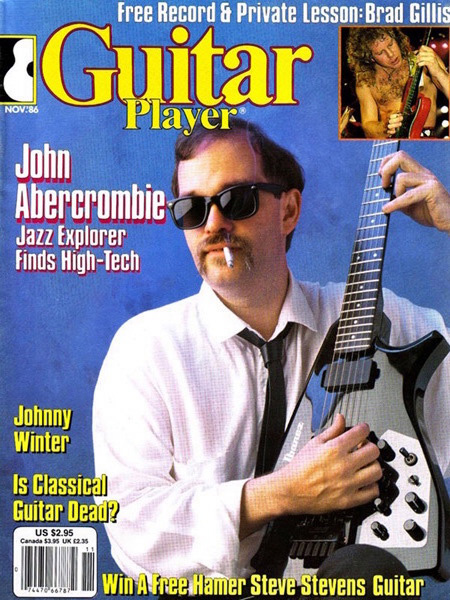
The Ibanez IMC-1 was the first guitar synthesizer system that I purchased, as it was the first one that showed some promise. Surprisingly the guitar itself was quite playable and sounded good straight into an amp. However, like most Pitch to Voltage systems, the bass strings tracked terribly and made playing intricate bass lines impossible, due to the lag and non-tracking issues with fast lines.
Overall though this was a decent system for playing solos, especially in the upper registers of the first and second string, which it tracked fairly well for the time. I also used it to input compositions into a DAW, though I had to “clean up” many “stray notes” which were sounded at a very low volume and are barely noticeable when playing live, but show up when displayed on a screen.
Yamaha G-10
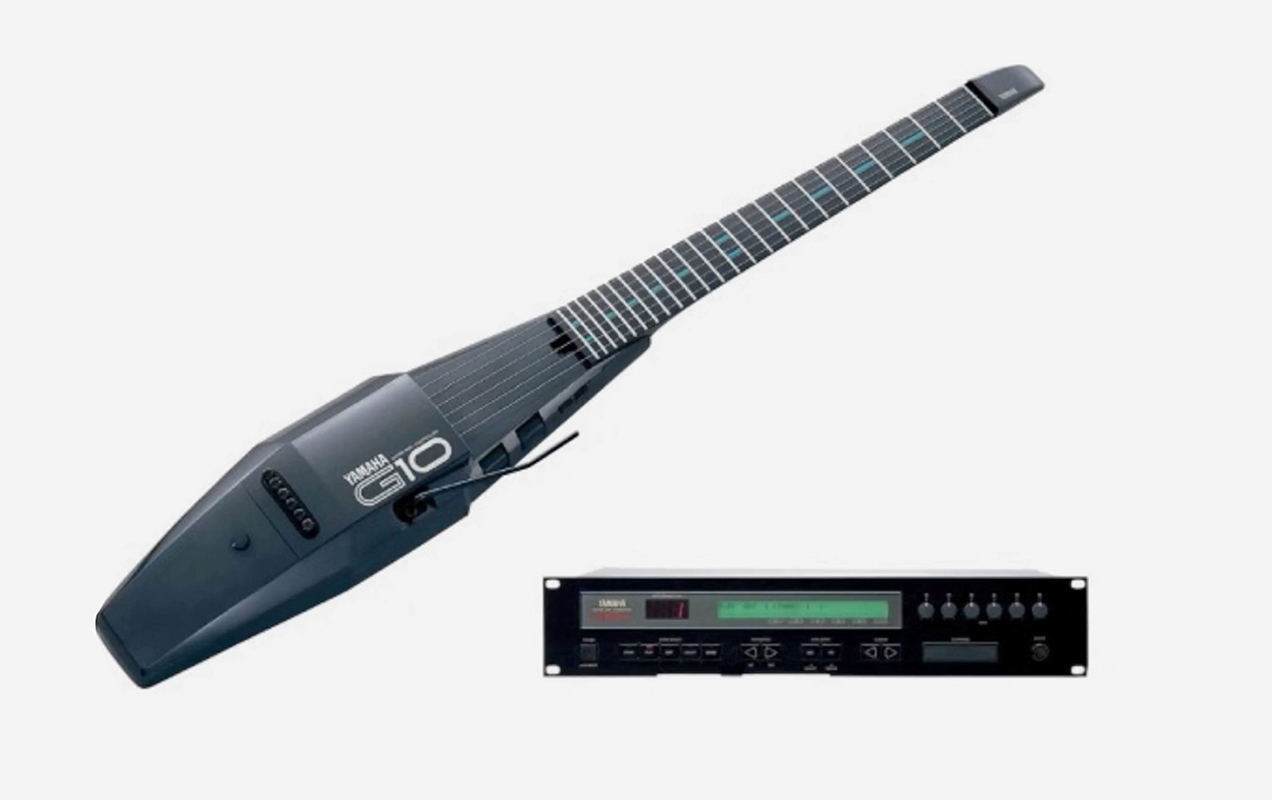
The Yamaha G-10 system was an excellent system at the time. This was the system that I used for most of my Fusion bands and it tracked really well. However, the downsides to this system is that it used all “G” strings, which was very annoying when playing at a lower volume, due to being able to hear the strings, whose notes didn’t match what you were playing. The system used a Sonar signal that sent along the length of the string and “anticipated” what you were going to play by knowing what note your finger was about to play before you played it, thus cutting down on the time to translate the note.
As mentioned above, the highlight of this system (besides the excellent tracking) was the inclusion of a Breath Controller input on the guitar. I used a Yamaha BC- 2 Breath Controller and there is nothing quite like “blowing” horn parts while playing – though there were times I would get a little “light headed” from doing this… not being used to breathing that hard while playing. I learned a lot about phrasing and such by having to breathe the actual notes, something many guitarists never really think about.
Fishman Triple Play
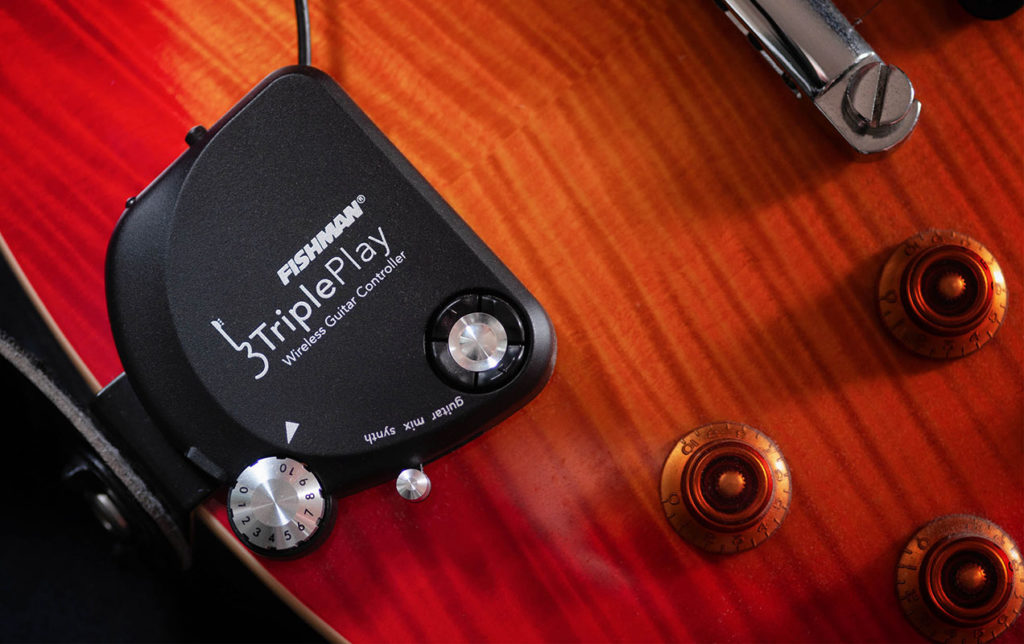
These days I’ve been using a Fishman Triple Play unit. This attaches to a “regular” guitar, and includes instructions and hardware for Les Pauls, Strats, etc. I’ve attached mine to a Les Paul. The pickup is attached to the bridge unit and has screws to adjust the height, while the converter/transmitter attaches to the endpin for the strap.
One of the benefits of this unit is that it is wireless and allows you to record and play live without having to deal with wires getting in the way. Of course of you use it with regular guitar output, you’ll still need a cord to go to the guitar amp for the guitar signal.
Although this is also a Pitch to Voltage unit, Fishman has developed both software and hardware that are able to track you’re playing remarkably well. Bass notes track nicely and lead tones track “perfectly”. As with any guitar synth, the way that you set up the sensitivity to match your playing technique goes a long way towards having good tracking.
The unit itself and the receiver both are charged via USB and hold the charge for quite a while. Even though the Yamaha G-10 tracked really well, I feel that this unit is better overall. Why? Mainly because it tracks really well, it allows you to use a regular guitar with regular strings and it is wireless for both stage and studio.
Synthesizers
While finding a controller that works well for you is important, your choice of synthesizer(s) and specific patches will determine your sound. The main synth types can be considered: Analog, Digital and Samplers. Of course there are units that combine these aspects into their own hybrid system.
Analog
I tend to prefer the warmth of Analog synths. These are particularly well for Pads and warm Lead tones. These also tend to have a much fatter sound than Digital synths.
I have used the following synths with excellent results:
Oberheim Matrix 6-R
Roland MKS -70 Super JX
Digital
Although I prefer Analog, make no mistake, I also like a good number of digital types of synths, as they tend to cut through mixes and have great definition. It should be kept in mind that when I played live I was always using a combination of both Analog and Digital synths at the same time, Analog for fatness and warmth and Digital for clarity and presence.
I was always happy with these units:
Yamaha TX-216 (2 rack mounted DX-7’s)
Kawai K1R
Roland D-110
Roland MT-32
Samplers
While I used several samplers over the years, they were primarily for recording purposes, as they were too “clumsy” for live use. Back in those days you had to actually load a sound into the sampler via a floppy disk, which made it awkward for use onstage.
I found that the Korg DSS-1 was a decent unit and it also had a keyboard, so it was my “go to” sampler for playing guitar synth or keyboards. Not surprisingly, when it came to recording with samplers years later, I moved on to Sample Libraries for desktop computers and no longer use dedicated hardware samplers.
Amplifiers
When it comes to playing guitar synths live, it is important to have a separate amp for your guitar and synthesizers. I have used a Pearce G1 guitar amp along with a Roland Keyboard Amp. Of course you can use any type of amp that you like for guitar and synth, but it is important to either have a keyboard amp or run your synths through a PA system. I had a large rack case that had a wall of rack mounted synths in it and I would run the outputs from the synths into a mixing board and then into a keyboard amp or PA.
The Players
Pat Metheny
Pat Metheny is the rare artist who not only developed his own unique guitar sound that has been imitated by hundreds of guitarists, but he also developed his own unique guitar synth sound, which is instantly recognizable. Here he is playing “Kin” with a killer group, including my favorite drummer, Antonio Sanchez.
Allan Holdsworth
The legendary Allan Holdsworth was also a connoisseur of guitar synth and has been linked to the impressive SynthAxe unit. Here he plays “Looking Glass” live with the SynthAxe.
John Abercrombie
One of Jazz’s endless explorers, John Abercrombie experimented with the guitar synth to add sounds to his personal pallette. Here he plays a Roland GR-700 guitar synth along with Michael Brecker.
John McLaughlin
John McLaughlin has always been interested in pushing the boundaries of his music, so it is no surprise that he has ventured into the realm of guitar synths. Here he is using a Roland G-303 driving a Synclavier and playing with killer players: Billy Cobham and Jonas Hellborg.
Final Thoughts
There are many benefits to using a guitar synth, from transcribing your own playing, composing with other instruments, orchestrating your live sound or just to have fun. I would highly recommend that you explore some of offerings available and see which one works best for your playing technique. Keep in mind that unless you are spending several thousands of dollars, there will always be some issue with the unit you choose, it’s just a matter of whether or not it is enough to discourage your use or not.
Guitar synths are a lot of fun, and are well worth dealing with their idiosyncrasies, for the amount of color they bring to your palette as a guitarist.


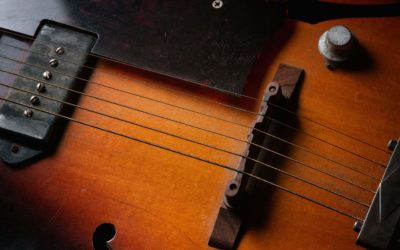
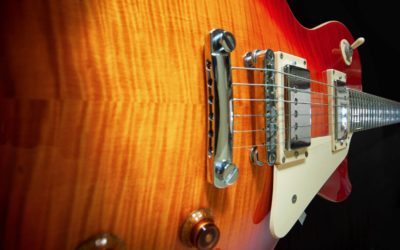
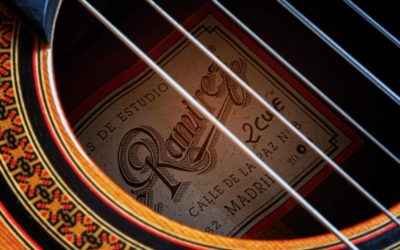
0 Comments